
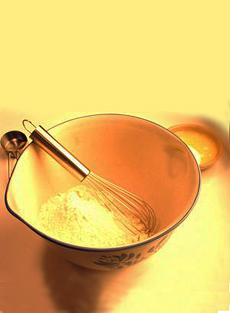
A good pancake or waffle starts with flour and a whisk. Photo by Daniel West | SXC.
September 2005
Updated September 2024
|
 |
Pancake & Waffle Glossary
What’s Up For Breakfast, Lunch & Dinner? Plenty!
Page 1: Terms Beginning With A & B
Who ever thought there were so many kinds of pancakes? There are dozens of varieties in Western culture alone, and countless varieties worldwide.
This is Page 1 of a six-page glossary of pancake and waffle types and terms. If you’d like to suggest additional words for inclusion, click here. Learn more about your other favorite foods in our 60+ food glossaries, including a Sugar & Syrup Glossary.
Click on a letter of the alphabet to get to the appropriate glossary page.
a b c d e f g h i j k l m n o p q r s t u v w x y z
This glossary is protected by copyright and cannot be reproduced in whole or part.
|
AEBLESKIVER
A Danish pancake that has a round ball-like shape rather than a round flattened shape, like a crêpe or a traditional flatbread pancake. The aebleskiver is made with a batter that is often mixed with fruit, preserves, or other fillings and poured into a pan with individual round indentations molded into it (see photo below) that creates a “pancake ball.” One half of the pancake bakes, and when the bottom half has turned golden brown it is rolled over manually to bake on the other side. Aebleskivers are most often served for breakfast or brunch, dusted with powdered sugar, but they can also be filled with savory ingredients and served as an appetizer. The Aebleskiver is also known as an Ableskiver, Aebelskiver, Ebleskiver, Danish Ball Pancake, Krapfchen, Merfeille, Norwegian Puff Ball, Poffertje, and Puffer.
|
|
AEBLESKIVER PAN
A cooking utensil designed specifically for making the Danish pancake ball known as an aebleskiver, ebleskiver, or apple dumpling. This pancake has a round ball-like shape rather than a round flattened shape, like a crêpe or a U.S. pancake. The aebleskiver is made with a batter that is often mixed with fruit or other fillings and poured into this pan with individual round indentations that are molded to form the ball shape. One half of the pancake bakes, and when the bottom half has turned golden brown it is rolled over manually to bake on the other side. Aebleskivers are most often served for breakfast or brunch, but they can also be filled with savory ingredients and served as an appetizer or main dish. The pan for aebleskivers is also referred to as a Munk pan or a Danish cake pan.
|
|
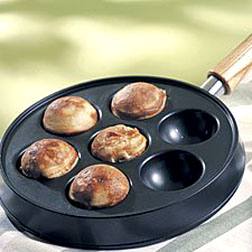
Aebleskiver, a Danish pancake. If you can’t find an aebleskiver pan locally, they‘re easy to find online.
SEE ALSO poffertjes, a Dutch version. |
|
AREPA
A flat meal cake made of maize flour, split in half and filled with cheese, deli meats and a variety of fillings. An arepa may be eaten closed like a sandwich or dressed with toppings and eaten open-faced. Although similar to a sandwich in its presentation, it can also be eaten as a side dish, in lieu of bread.
|
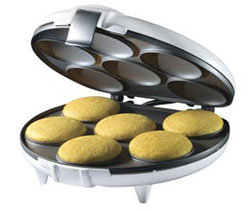
Want to make hot arepas on your countertop? Get an Oster arepa maker. |
|
BAMMY
A Jamaican pancake made from cassava root that has been grated and pressed to remove the bitter juice. Bammy is often served with fried fish and other fried foods.
|
BANNOCK
Popular in Scotland, bannock is thinner than a scone. It is a form of flat cake, baked on a griddle, and is generally made of oatmeal and takes the form of a large oatcake. However, the meaning is not universal; some Scots use the term to refer to a large wheat flour cake similar to a large thin scone. Bannocks are also quite popular in eastern Canada, especially in the Atlantic provinces.
BELGIAN WAFFLE or
BELGIUM WAFFLE
In Belgium, there is no such thing as a “Belgian” waffle (just as there are no “French fries” in France). Every region has its own style of waffle (called a gauffre), and there are two major types: the Brussels waffle and the Liège waffle. What we know as the Belgian waffle is actually the Brussels waffle, a dessert waffle usually eaten with a knife and fork. The Belgian waffle got its name at the 1964 World’s Fair in New York City, where it was served with whipped cream and strawberries (the manager of the Belgian pavilion, Maurice Vermesch, named it the Belgian waffle because he did not think many people would be familiar with Brussels). Belgians typically eat waffles for dessert this way, or with other sweet toppings including powdered sugar, ice cream, butter and sugar or syrup, with chocolate syrup or other fresh fruit.
|
|
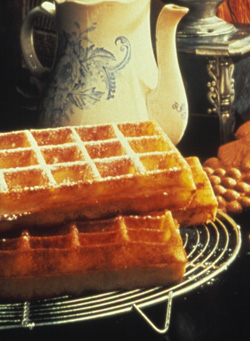
Belgian waffles (above) are rectangular or square; Liège waffles are irregular in shape. Read more about the differences of each style. copyright © of the Belgian Tourist Office NYC/USA, VisitBelgium.com. |
Belgian waffles are square or rectangular and even, with deep divots. They are made from a batter that includes yeast and beaten egg whites; this gives them a lighter texture and fluffier consistency than the typical American waffle, which tends to have baking soda or powder in the batter (and is often just pancake batter poured into a waffle iron). They are also very crisp. Belgians do not eat waffles for breakfast, but they do eat the Liège waffle as a snack.
|
BLINTZ or BLINTZE or BLIN
A crêpe-like thin pancake that may be eaten “as is,” in which case the batter may contain various add-ins, from grated potato or apple to raisins. These blini are quite common in Eastern Europe and are more solidly filled than the spongy pancakes usually eaten in North America.
A blintz is typically a thicker filled crêpe, filled with sweetened cheese, fruit, or potatoes, pan-fried, and often served with sour cream or applesauce.
|
|
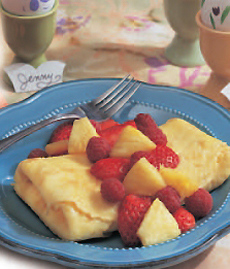
Photo of blintzes with fresh fruit courtesy of American Egg Board. |
|
BLINI
Blini may be spread with butter, bacon fat, or jam, topped with caviar, and served flat, folded, or rolled into a tube. They can be made in a thickness resembling American pancakes, or in thinner forms like Swedish pancakes and French crêpes. They can be made from wheat or buckwheat: buckwheat blini were created in Russia specifically to enhance caviar, and they became popular with less luxurious toppings as well. Because buckwheat requires a good deal of care to grow and process, it became a rare commodity during the difficult times of the former Soviet Union. The word blin comes from Old Slavic mlin, meaning “to mill.” Blins had a somewhat ritual significance for early Slavic peoples in pre-Christian times: with their round form, they were a symbol of the sun.
|
|
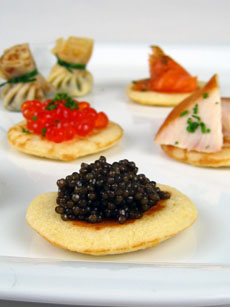
Rich man’s blini, shown here with beluga caviar, salmon caviar, smoked salmon, and sturgeon, are as delicious topped with butter
or jam. This photo and blini photo below, courtesy of Caviar Russe restaurant, New York.
|
|
Blini were traditionally prepared at the end of the winter to honor the rebirth of the new sun (Pancake Week, in Russian). This tradition was adopted by the Orthodox church and is carried on to the present day. Blini are also served at wakes, to commemorate the deceased. The term blintz is mostly applicable to the kind that is filled with jam, fruit, cottage cheese or other cheese, ground meat, or poultry; then rolled or folded and lightly fried, sautéed or baked. They are also called nalysnyky in this form.
|
|
BUCKWHEAT FLOUR
A gluten-free flour made by grinding seeds of the buckwheat plant. Despite its name, buckwheat is technically a fruit, unrelated to wheat. It came to Europe from China. Buckwheat flour has a slightly tangy flavor and is often processed with the addition of wheat flour to neutralize the taste, but we love the full flavor of buckwheat. It is often used for making blintzes, pastas, pancakes, and waffles; the Russians created buckwheat blini as a counterpoint to the saltiness of the caviar. It is a lovely counterpoint with maple syrup as well.
|
|
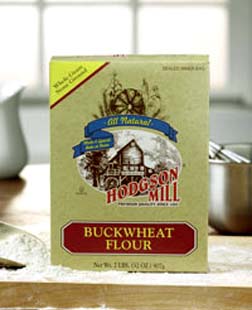
Make your own buckwheat pancakes with
gluten-free buckwheat flour. Click here to buy this top-quality stone-ground flour from one of our favorite mills.
|
|
BLUE CORN or BLUE
CORNMEAL
Blue corn is a floury corn with about 30% more protein than today’s hybrid yellow corn. It has a stronger, nuttier flavor than regular cornmeal. It has been a staple in Mesoamerica since pre-Columbian times; it is used to make tortillas, chaquegue (a gruel), and nixtamal (a type of hominy). Blue corn was also reputed to have healing properties when offered as a beverage. Today it is ground into masa flour and used for muffins, pancakes, tamales, tortilla chips and more. Products made from it have a blue tinge. For more information see cornmeal.
|
|
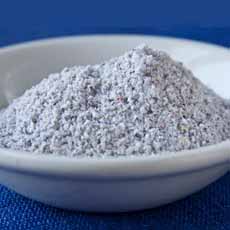
Blue cornmeal (photo courtesy Muffin Tin Mania). |
Continue To Page 2: Terms Beginning With C To F
Go To The Alphabet Index Above
Some information in this glossary is courtesy of Wikipedia, the free encyclopedia.

|











